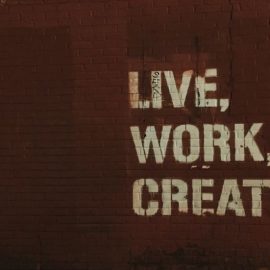

This article is an excerpt from the Shortform book guide to "Mastery" by Robert Greene. Shortform has the world's best summaries and analyses of books you should be reading.
Like this article? Sign up for a free trial here .
Is your creativity getting you anywhere? What’s getting in your way on your path toward creative power and independence?
In the book Mastery, Robert Greene identifies creative independence as the second stage of mastery. It comes after you’ve established a foundation of skills and knowledge—when you’ve come to a point where you can apply these in your own way. He offers four tips on how to cultivate creativity: commit to a creative project, keep your mind flexible, create a major insight, and overcome emotional obstacles.
Keep reading for details on these recommendations.
Cultivating Creativity
According to Greene, achieving creative independence requires you to develop a certain kind of mind—a flexible, explorative mind that combines childlike wonder with the experience and skills from your foundational training. He explains the three types of mind we can have as we mature:
- Mind #1: The child’s mind. In childhood, we’re naturally open and bright-eyed. Children unashamedly ask unusual, piercing questions about things that adults take for granted—such as why the sky is blue. Greene says the child’s mind embraces wonder and openness, but it lacks experience or practical skills.
- Mind #2: The conditioned mind. As we age, we gain skills and experience, and we’re conditioned by our cultures to look at the world in a certain way. We become more experienced, yet also more conventional and prone to rigid, uncreative thinking. Such an adult might scoff and dismiss a child’s question as naive and silly.
- Mind #3: The creative mind. The rare few—masters—combine the wonder and openness of children with the experience and knowledge of adults. This produces a mind that can think freely and execute with discipline—that is, a master can produce highly creative ideas and has the discipline to act on them.
| Could Myelination Cause a Rigid Mind? While Greene argues for the existence of three types of mind, he doesn’t provide any research to support his claim. However, his assertion that the mind becomes rigid over time might follow from the fact that regularly used neural pathways undergo myelination. Every time you perform an action, the corresponding neurons, or brain cells, send signals to each other along neural pathways via fibers called axons. The axons are wrapped in a fatty insulating tissue called myelin, which accelerates transmission speed. The more you practice a skill, the more myelinated those axons become, and the more effortlessly you’ll perform the action. For instance, well-myelinated neural pathways for soccer yield second-nature soccer skills—in other words, they become automatic. When a daily routine becomes automatic, we call it a habit. We often carry out our habits unconsciously, taking them for granted as “who we are,” even if we haven’t consciously examined where those habits came from. What Greene warns against is the crystallization of these habits; in the brain, they become heavily myelinated, thus hard not to perform. |
Here are Greene’s tips on how to cultivate creativity on the path toward creative freedom and mastery.
#1: Commit to a Creative Project
The first step in cultivating a creative mind is to commit to a creative project. Any master has a project that calls to them. Find what you’re naturally drawn to in your field—a project you feel like you’re meant for—by listening to your inner sense of direction. Feeling deeply connected to the project helps you stay committed when things get tough.
Greene recommends finding this project by reflecting on the disagreements you have with the existing paradigm in your field. Creativity means pushing boundaries, so finding an opportunity to challenge accepted answers can lead to highly creative work.
(Shortform note: In The Art of Learning, Josh Waitzkin argues that staying true to your personal style is crucial to success, even if it goes against the accepted wisdom. In his view, honoring your style grounds you and sustains your passion for the skill. When Waitzkin was forced by a disciplinarian chess teacher to play in a way that went against his intuition, he fell out of love with the game. Later, he found his passion in tai chi, a martial art that allowed him to express his chess intuition in a wholly new way.)
#2: Keep Your Mind Flexible
As you pursue your project, practice stretching your mind to remain creative. According to Greene, our minds naturally tighten up over time—that is, we settle into certain ways of thinking. However, sticking with what you know isn’t creativity. Greene offers several practices for keeping your mind flexible:
Practice #1: Sit with uncertainty. When faced with difficult questions or uncertainties, patiently ponder the unknown and remain open to all possibilities. Taking the time to consider every angle surfaces novel ideas and prevents you from recycling familiar answers as a shortcut.
(Shortform note: In Contemporary Psychotherapy, Diana Voller writes of “negative capability” as the ability to remain in the mystery of the unknown and to allow uncertainty to persist. She argues that while this is likely easier for certain personality types, you can develop it by engaging with the big questions—things like “what is the purpose of art?” or “what does it mean to contribute to the world?” These questions demand well-thought-out answers, so you’ll need to wade through uncertainty to reach worthwhile conclusions.)
Practice #2: Stimulate chance associations. Greene explains that creative ideas often come from chance associations of seemingly unrelated ideas. Create the conditions for fortuitous associations by regularly relaxing: Our best ideas often come to us when we loosen up since the mind can defocus and wander freely.
(Shortform note: In Steal Like An Artist, Austin Kleon corroborates Greene’s advice: He suggests setting aside regular time for hobbies and allowing yourself to feel bored. Hobbies can spur new connections—for instance, sketching can improve your ability to visualize a work-related project. Feeling bored allows your mind to wander, so that you find ideas you otherwise wouldn’t encounter.)
Practice #3: Iterate your ideas. According to Greene, masters alternate between working on their ideas and testing what they’ve worked out. For example, a scientist might observe something—such as gravity—and develop an initial theory, then test it to validate her ideas.
(Shortform note: In Black Box Thinking, Matthew Syed recommends learning and innovating through trial and error, much like Greene’s advice above. Syed argues that mistakes show you where and how your ideas are wrong, thus revealing what you need to do to improve. Each time you learn from a mistake, you take a step forward. In fact, Syed argues that this is the basis of all learning—that is, mistakes are intrinsic to the learning process.)
Practice #4: Use all your senses. Greene explains that many of our senses are stronger than language-based thinking. Visual memory is stronger than linguistic memory, and drawing, visualizing, and diagramming your ideas can spark creative associations and improve your mental model of the ideas. In addition, some masters used scents, sounds, or colors to stimulate them.
(Shortform note: One study suggests that synaesthetes—people who experience synaesthesia, or sensory mixing—have a greater ability to form creative associations. For example, some synaesthetes associate visual input with sound—seeing colors when you hear music, or vice versa—so they can produce creative audio-visual media, such as music videos. This supports Greene’s notion that diverse sensory input bolsters creativity.)
#3: Create a Major Insight
According to Greene, past masters all reached their highest achievements by pushing through intense creative tension and, ultimately, letting go to allow the solutions to arise. He outlines this way of reaching a major insight as follows:
1. The aspiring master first gathers ideas and experiments, before deciding on her direction.
2. She then pursues her work with intense focus, using various strategies such as those in the previous section.
3. Due to this intense focus and the natural doubts and struggles of creative works, she builds toward a point of very high tension. At this point, she struggles to complete her work.
4. Greene asserts that she must step away from the work and rest. By getting away from the source of her tension, she allows her mind space to loosen up and freely associate the ideas she’s been working with. Then, her mind can synthesize the ultimate solution to her work.
This process of working through a peak of tension, Greene says, is what led masters like Einstein—who allegedly gave up on his project just before finding the solution—to do their greatest works.
(Shortform note: In Steal Like An Artist, Austin Kleon recommends using tension and limitations to improve your work. Giving yourself fewer options encourages resourcefulness, because you have less to work with. For instance, you might try to compose a song with only three notes.)
#4: Overcome Emotional Obstacles
As Greene explains, performing creative work in a public arena means you’ll come under scrutiny. Self-doubt and inner tension are part and parcel of the creative life, and you can navigate them on your path toward creative freedom by watching for the following traps:
- Obstacle #1: Cynicism. As we learn and gain experience, many people grow cynical and believe they’ve seen it all. Avoid this by embracing wonder and remaining humble.
- Obstacle #2: Self-importance. Don’t let praise go to your head. Instead, focus on your creative process, and counterbalance praise by regularly critiquing your own work.
- Obstacle #3: Dependence. When you become independent, you might flounder and seek outside approval. To avoid this, become self-reliant and set your own standards.
- Obstacle #4: Mental rigidity. Greene explains that creativity requires constant fluctuation between intense focus and relaxed optimism. Avoid fixating on either extreme, and learn to focus or relax as needed.
- Obstacle #5: Impatience. Significant creative work takes time and effort, and it’s easy to get impatient. Instead, do your best every day, and work patiently toward your goals.
| More Obstacles to Mastery In Mastery: The Keys to Success and Long-Term Fulfillment, George Leonard similarly describes 13 pitfalls that can knock you off the path to mastery. Like Greene, he cites laziness (impatience), ego (self-importance), and excessive seriousness (mental rigidity). He adds a few others: Being overly goal-oriented—While reaching milestones does matter, you need to keep your eyes on the path to get there. Over- or under-competitiveness—Competition motivates us to refine our skills to ever-greater heights, but focusing excessively on first place will make you egotistical. Reward-seeking—People tend to stop trying when they get a reward, like a medal or recognition. In other words, rewards can make you complacent. Inconsistency—If you lack routines, you’ll have a harder time showing up for practice and making steady progress. |

———End of Preview———
Like what you just read? Read the rest of the world's best book summary and analysis of Robert Greene's "Mastery" at Shortform .
Here's what you'll find in our full Mastery summary :
- The clear path anyone can follow to achieve mastery
- An explanation of the three stages of mastery
- How learned conventions and familiar ways of thinking reduce creativity






